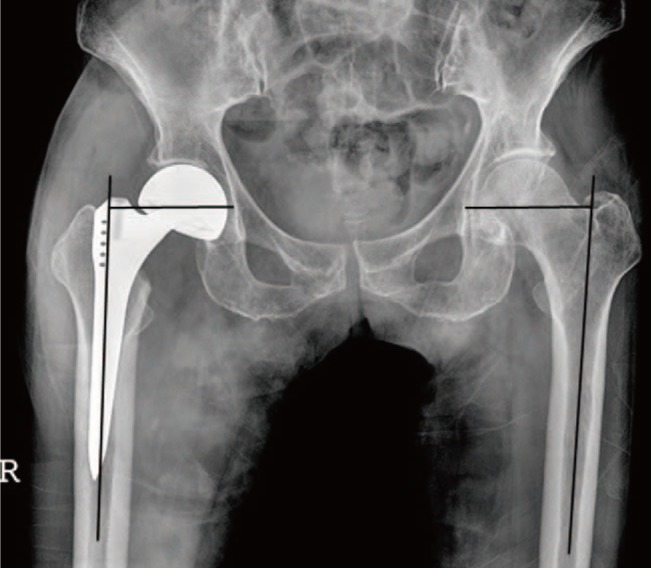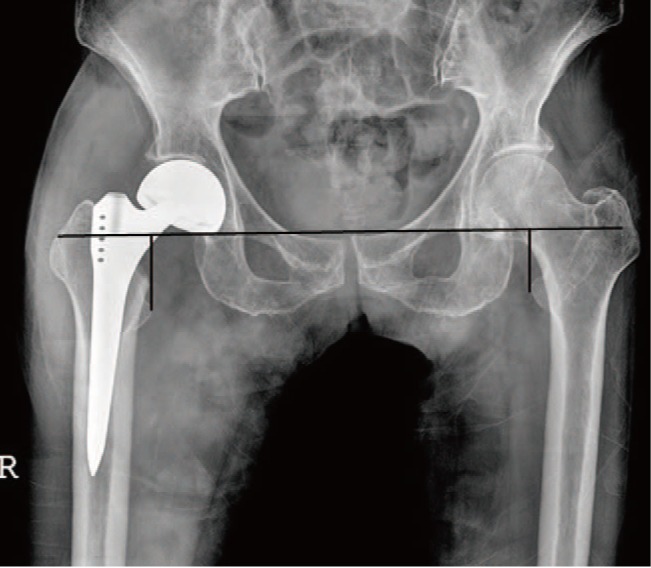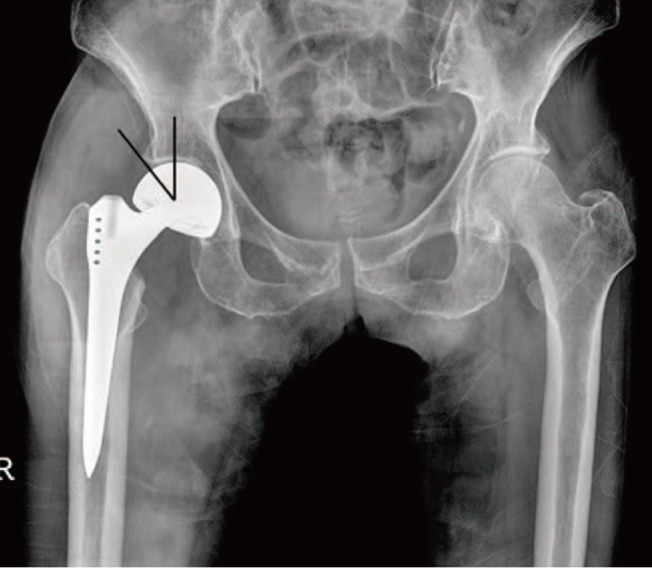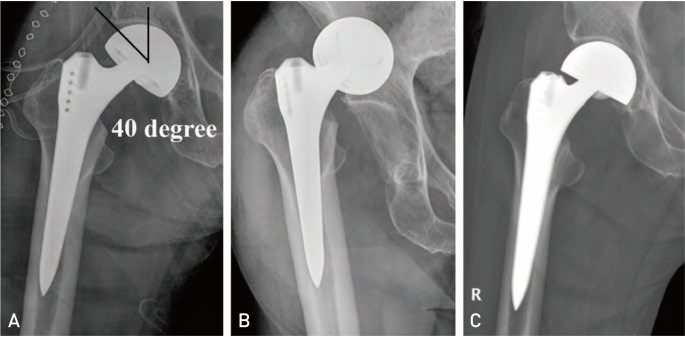Hip Pelvis.
2016 Jun;28(2):104-111. 10.5371/hp.2016.28.2.104.
Risk Factors Associated with Dislocation after Bipolar Hemiarthroplasty in Elderly Patients with Femoral Neck Fracture
- Affiliations
-
- 1Department of Orthopedic Surgery, Hanyang University Hospital, Seoul, Korea.
- 2Department of Orthopaedic Surgery, Hanyang University Guri Hospital, Guri, Korea. kimyh1@hanyang.ac.kr
- KMID: 2328346
- DOI: http://doi.org/10.5371/hp.2016.28.2.104
Abstract
- PURPOSE
We investigated the incidence and time of dislocation and other factors associated with dislocation of bipolar hemiarthroplasty related to the treatment of femoral neck fracture in old age patients.
MATERIALS AND METHODS
Between January 2002 and April 2014, 498 femoral neck fractures (467 patients) were treated with bipolar hemiarthroplasty and included in this study. All surgeries were performed using the postero-lateral approach. The incidence of dislocation was investigated. A comparative analysis between a control group and dislocation group was performed with respect to patient factors including age, gender, body mass index, comorbidities, the ASA (American Society of Anesthesiologists) score, mental status and center-edge angle, and surgical factors including type of femoral stem, leg length discrepancy, femoral offset and method of short external rotator (SER) reconstruction.
RESULTS
The incidence of dislocation was 3.8%, and the dislocation occurred on average 2.2 months (range, 0.6-6.5 months) after operation. No difference in patient-related factors was observed between the two groups. However, a smaller center edge (CE) angle was observed in the dislocation group (42.1°±3.2° vs. 46.9°±5.4°, P<0.001), and significantly lower incidence of dislocation was observed in tendon to bone repair group (0.7% vs 7.8%, P<0.001).
CONCLUSION
SERs should be repaired using the tendon-to-bone repair method to reduce dislocation rate in elderly patients who undergo bipolar hemiarthroplasty using the postero-lateral approach due to femoral neck fracture. In addition, patients with smaller CE angle should be carefully monitored due to high incidence of dislocation.
MeSH Terms
Figure
Reference
-
1. Klop C, Welsing PM, Cooper C, et al. Mortality in British hip fracture patients, 2000-2010: a population-based retrospective cohort study. Bone. 2014; 66:171–177. PMID: 24933345.
Article2. Brozek W, Reichardt B, Kimberger O, et al. Mortality after hip fracture in Austria 2008-2011. Calcif Tissue Int. 2014; 95:257–266. PMID: 24989776.
Article3. Turner RS. Postoperative total hip prosthetic femoral head dislocations. Incidence, etiologic factors, and management. Clin Orthop Relat Res. 1994; (301):196–204. PMID: 8156674.
Article4. Moore AT. The self-locking metal hip prosthesis. J Bone Joint Surg Am. 1957; 39-A:811–827. PMID: 13438939.
Article5. Hardinge K. The direct lateral approach to the hip. J Bone Joint Surg Br. 1982; 64:17–19. PMID: 7068713.
Article6. Suh KT, Park BG, Choi YJ. A posterior approach to primary total hip arthroplasty with soft tissue repair. Clin Orthop Relat Res. 2004; (418):162–167. PMID: 15043109.
Article7. Ko CK, Law SW, Chiu KH. Enhanced soft tissue repair using locking loop stitch after posterior approach for hip hemiarthroplasty. J Arthroplasty. 2001; 16:207–211. PMID: 11222895.
Article8. Pellicci PM, Bostrom M, Poss R. Posterior approach to total hip replacement using enhanced posterior soft tissue repair. Clin Orthop Relat Res. 1998; (355):224–228. PMID: 9917607.
Article9. Mukka S, Lindqvist J, Peyda S, et al. Dislocation of bipolar hip hemiarthroplasty through a postero-lateral approach for femoral neck fractures: a cohort study. Int Orthop. 2015; 39:1277–1282. PMID: 25557759.
Article10. Madanat R, Mäkinen TJ, Ovaska MT, Soiva M, Vahlberg T, Haapala J. Dislocation of hip hemiarthroplasty following postero-lateral surgical approach: a nested case-control study. Int Orthop. 2012; 36:935–940. PMID: 21931967.
Article11. Ninh CC, Sethi A, Hatahet M, Les C, Morandi M, Vaidya R. Hip dislocation after modular unipolar hemiarthroplasty. J Arthroplasty. 2009; 24:768–774. PMID: 18555648.
Article12. Barnes CL, Berry DJ, Sledge CB. Dislocation after bipolar hemiarthroplasty of the hip. J Arthroplasty. 1995; 10:667–669. PMID: 9273380.
Article13. Bhuller GS. Use of the giliberty bipolar endoprosthesis in femoral neck fractures. Clin Orthop Relat Res. 1982; (162):165–169. PMID: 7067210.
Article14. Petersen MB, Jørgensen HL, Hansen K, Duus BR. Factors affecting postoperative mortality of patients with displaced femoral neck fracture. Injury. 2006; 37:705–711. PMID: 16765352.
Article15. Chang JD, Yoo JH, Lee SS, Kim TY, Jung KH, Kim YK. Bipolar hemiarthroplasty for hip fractures in patients aged over 90 years - the factors influencing the postoperative mortality. J Korean Hip Soc. 2010; 22:283–290.16. Lim CH, Chung YY, Kim JS, Kim CY. Hemiarthroplasty for hip fractures in elderly patients over 80 years old-comparative analysis between femoral neck fracture and intertrochanteric fracture. Hip Pelvis. 2013; 25:44–50.17. Alarcón T, González-Montalvo JI, Bárcena A, Saez P. Further experience of nonagenarians with hip fractures. Injury. 2001; 32:555–558. PMID: 11524088.
Article18. Ooi LH, Wong TH, Toh CL, Wong HP. Hip fractures in nonagenarians--a study on operative and non-operative management. Injury. 2005; 36:142–147. PMID: 15589932.
Article19. Iorio R, Schwartz B, Macaulay W, Teeney SM, Healy WL, York S. Surgical treatment of displaced femoral neck fractures in the elderly: a survey of the American Association of Hip and Knee Surgeons. J Arthroplasty. 2006; 21:1124–1133. PMID: 17162171.20. Raaymakers EL. Fractures of the femoral neck: a review and personal statement. Acta Chir Orthop Traumatol Cech. 2006; 73:45–59. PMID: 16613748.21. Kim SH, Lee SW, Kong GM, JeaGal MU. Comparison between the results of internal fixation using proximal femur nail anti-rotation and bipolar hemiarthroplasty in treatment of unstable intertrochanteric fractures of elderly patients. J Korean Hip Soc. 2012; 24:45–52.
Article22. Gregory RJ, Gibson MJ, Moran CG. Dislocation after primary arthroplasty for subcapital fracture of the hip. Wide range of movement is a risk factor. J Bone Joint Surg Br. 1991; 73:11–12. PMID: 1991741.
Article23. Pajarinen J, Savolainen V, Tulikoura I, Lindahl J, Hirvensalo E. Factors predisposing to dislocation of the Thompson hemiarthroplasty: 22 dislocations in 338 patients. Acta Orthop Scand. 2003; 74:45–48. PMID: 12635792.
Article24. Weeden SH, Paprosky WG, Bowling JW. The early dislocation rate in primary total hip arthroplasty following the posterior approach with posterior soft-tissue repair. J Arthroplasty. 2003; 18:709–713. PMID: 14513442.
Article25. Sherman SL, Copeland ME, Milles JL, Flood DA, Pfeiffer FM. Biomechanical evaluation of suture anchor versus transosseous Tunnel quadriceps tendon repair techniques. Arthroscopy. Published online February 16, 2016. DOI: 10.1016/j.arthro.2015.11.038.
Article26. Enocson A, Tidermark J, Tornkvist H, Lapidus LJ. Dislocation of hemiarthroplasty after femoral neck fracture: better outcome after the anterolateral approach in a prospective cohort study on 739 consecutive hips. Acta Orthop. 2008; 79:211–217. PMID: 18484246.
Article27. Yoon US, Kim KW, Kim YH, et al. The treatment of the hip fracture in the dementia patients. J Korean Soc Fract. 1999; 12:767–772.
Article
- Full Text Links
- Actions
-
Cited
- CITED
-
- Close
- Share
- Similar articles
-
- Unipolar Versub Bipolar Hip Hemiarthroplasty for Fractures of Femoral Neck in the Dlderly
- Dislocation after Bipolar Hemiarthroplasty of the Hip
- Experience with Bipolar Hemiarthroplasty in Femoral Neck Fracture in the Elderly Patients: Correlation Between Preoperative Medical Conditions and Postoperative Functional Results of Hip
- The Clinical Resuts of Bipolar Hemiarthroplasty in Old Age-Femoral Neck Fracture vs. Intertrochanteric Fracture-
- Evaluation of Quality of Life after Treatment of Femoral Neek Fracture in Elderly Patieno





